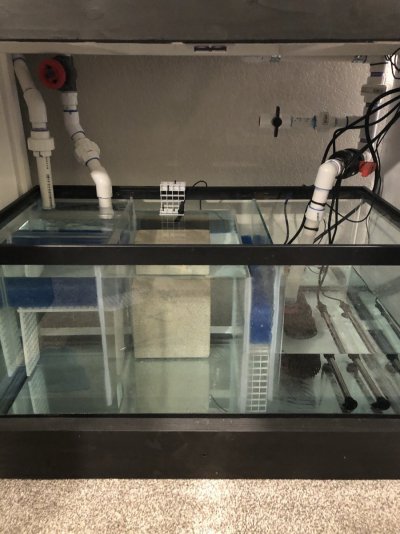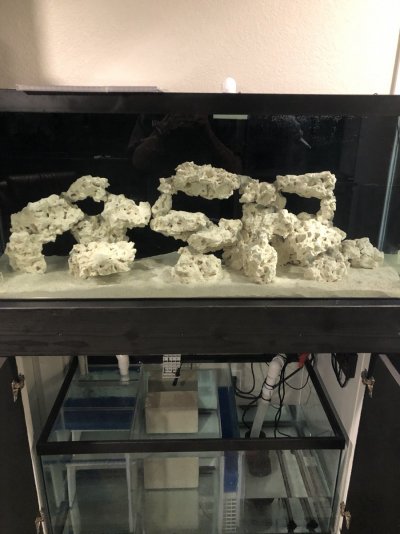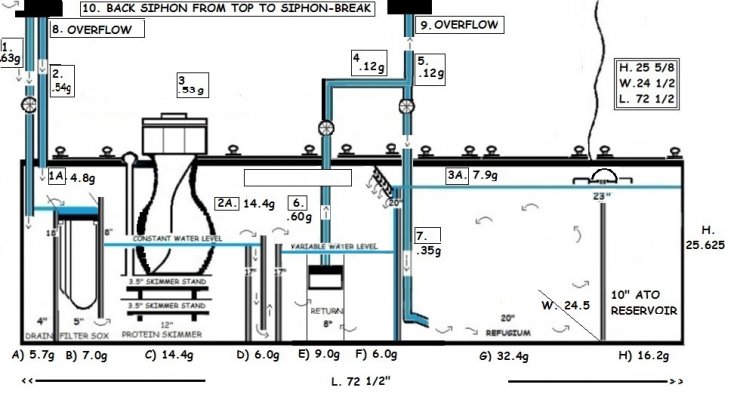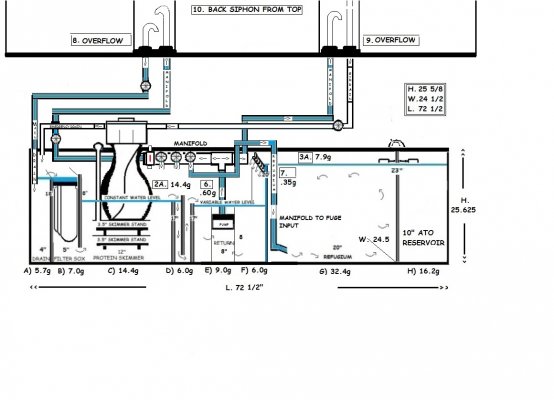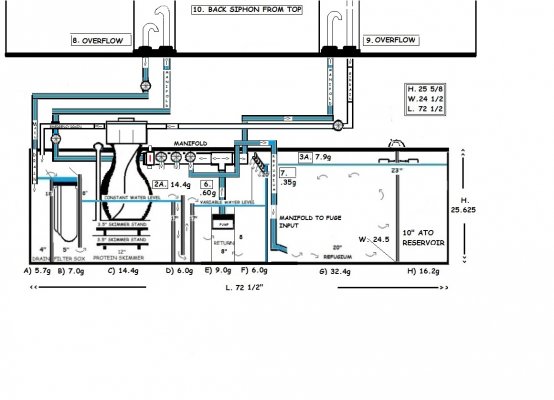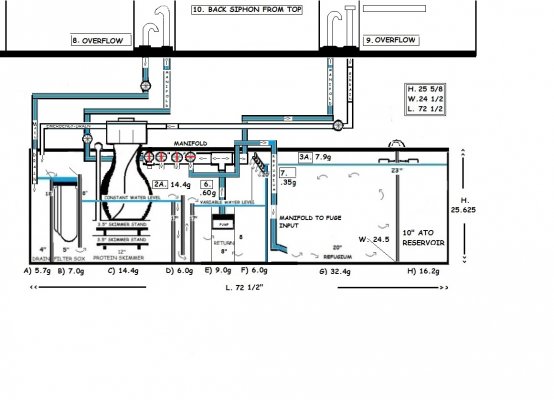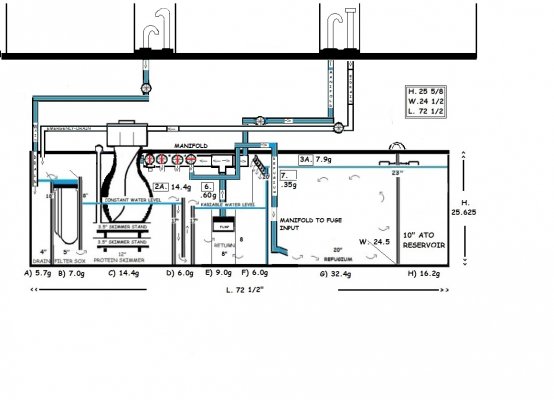otherwise, yeah i'd choose it
Navigation
Install the app
How to install the app on iOS
Follow along with the video below to see how to install our site as a web app on your home screen.
Note: This feature may not be available in some browsers.
More options
You are using an out of date browser. It may not display this or other websites correctly.
You should upgrade or use an alternative browser.
You should upgrade or use an alternative browser.
sump design ideas?
- Thread starter Ro Bow
- Start date
- Tagged users None
Build your own stand, I really don’t like there cheap partial board stands.. paint gets chipped and they swell like a ballon when wet. Not only that, but you will create more options for equipment. It is not that hard and WAY stronger. I built mine for my 75g and made sure I could house my 40b sump. When the pumps shut off, I made sure it would hold several gallons more than what would return to sump. Here are some pics.
Attachments
IMO, building your own sump is one of the most fun and educational things you can do in this hobby. It's SO much easier these days with the baffle kits that are now available. Many are designed for specific cheap, mass-market tanks that you can buy at any pet store, so they fit perfectly. One word of caution: make sure you have plenty of capacity for siphoned water when the power is shut off! Whatever overflow you're using will dump some amount of DT water into your sump when the return pump turns off until your drain siphon break level is hit. Speaking of which, make sure you have a siphon break on your return line!
PeterC99
Solarbenchmark.com
View Badges
Excellence Award
Reef Tank 365
NJRC Member
Hudson Valley Reef Keepers
Hospitality Award
My Tank Thread
My Aquarium Showcase
Great advice about extra capacity for siphoning!IMO, building your own sump is one of the most fun and educational things you can do in this hobby. It's SO much easier these days with the baffle kits that are now available. Many are designed for specific cheap, mass-market tanks that you can buy at any pet store, so they fit perfectly. One word of caution: make sure you have plenty of capacity for siphoned water when the power is shut off! Whatever overflow you're using will dump some amount of DT water into your sump when the return pump turns off until your drain siphon break level is hit. Speaking of which, make sure you have a siphon break on your return line!
Hi, Ok here is what I have come up with now... thanks to y'all's help. I have a problem because I can't find the dimensions for the overflow boxes in the tank and I don't know how much water will back-flow from the top of the tank and the overflows with the pump off. I called Aqueon and the guy there said that it would depend on what the flow-rate was. Since the pump will be off and there is no flow-rate wouldn't the back-siphon depend on where the siphon-break was adjusted to? He insisted that the speed of the pump would control the siphon... how will I know how much to adjust the return pipe or is it a matter of wild asp guess? Sometimes I feel like I'm in over my head BUT, I'm lovin' every minute of it!!! Thanks for your patience, your feedback means a lot to me! If anyone has an Aqueon 180 and you know the dimensions of the overflows, I'd really appreciate it if you wouldn't mind sharing those with me... Thanks!
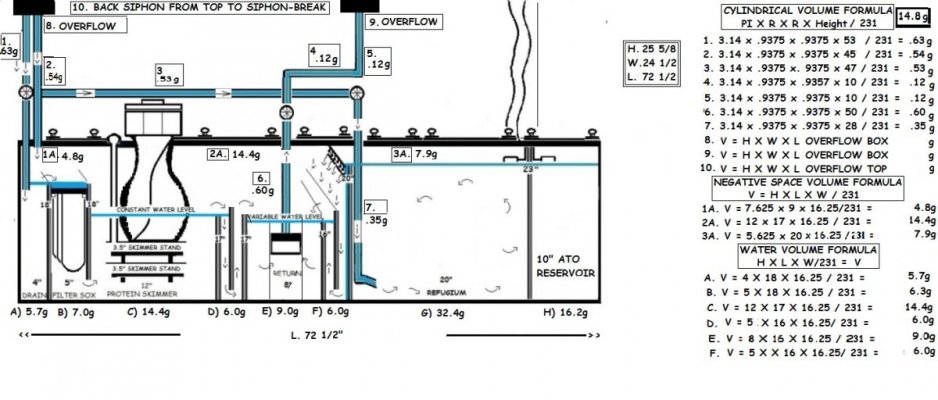

Great planning diagram! You put mine to shame! A few points/suggestions:
1) Draining volume: The reason he said it would depend on flow rate is because flow rate will affect water level in the DT. If your flow rate is above the max rate that the return plumbing can handle, the water level in the DT will be higher than if your flow rate was at or below the return plumbing max flow rate. Therefore, the volume of water draining into the sump after pump shutoff will be variable and directly related to your return pump flow rate. The optimal flow rate for my 300G Marineland tank is 600 gph according to the manufacturer. Originally, I matched my return pumps to that, but later jacked up the flow to get more turnover in my system. The water level in the DT went up and so did the power-off drain volume. I don't know how to predict the drain volume though. Maybe estimate max possible drain volume by measuring height from first siphon break to top rim of your DT and then multiply by width and length? That's probably overkill because you're not going to want to run your system with water level right at the tip top of your DT.
2) Filter sock section: is there a raised lip on the right side of the holder to keep water from flowing over the top into the skimmer section? I can't tell from the drawing. You want one, but not too high so that if the socks get clogged, you can still overflow into the skimmer section (rather than over the top of your sump onto the floor!)
3) Baffles: are you going to use adjustable baffles? I'd definitely suggest using kits that have the adjustable ones because it just makes life so much easier for optimizing skimmer performance and working sump volume.
4) Refugium: In my experience, it's much better to put "clean" water (from the return pump section) into the refugium rather than dirty water from the drain. Otherwise you collect all sorts of detritus in the refugium and whatever compartment it drains into and are constantly having to clean them out. I'd suggest using your return pump to feed the refugium and then drain the refugium via plumbing into the skimmer section. The skimmer section baffles will handle the bubbles from the refugium return and then you can get rid of the second set of baffles in the pump section which will save you space.
5) UV: I've come to believe that a UV sterilizer is essential equipment for any 90+ gallon reef tank. I don't want to start a debate with people over this here though. However, why not give yourself future flexibility to add a UV (or who knows what else) by building a fancier return pump manifold that has a T junction with a high quality ball valve union coming off the side? You can keep the ball valve closed and it can be connected to nothing for now, but it'll save you a lot of time and headache later if you eventually need to hook up more equipment that runs off your return. For the ball valve, I'd get something like this: https://www.bulkreefsupply.com/cepex-ball-valve.html and use the threaded union for the empty end for easy swap-out.
6) ATO: I'm not clear on whether the ATO is completely isolated or if there's a connection into the refugium
Anyway, sorry for the long reply but hopefully there are a couple useful suggestions in here
1) Draining volume: The reason he said it would depend on flow rate is because flow rate will affect water level in the DT. If your flow rate is above the max rate that the return plumbing can handle, the water level in the DT will be higher than if your flow rate was at or below the return plumbing max flow rate. Therefore, the volume of water draining into the sump after pump shutoff will be variable and directly related to your return pump flow rate. The optimal flow rate for my 300G Marineland tank is 600 gph according to the manufacturer. Originally, I matched my return pumps to that, but later jacked up the flow to get more turnover in my system. The water level in the DT went up and so did the power-off drain volume. I don't know how to predict the drain volume though. Maybe estimate max possible drain volume by measuring height from first siphon break to top rim of your DT and then multiply by width and length? That's probably overkill because you're not going to want to run your system with water level right at the tip top of your DT.
2) Filter sock section: is there a raised lip on the right side of the holder to keep water from flowing over the top into the skimmer section? I can't tell from the drawing. You want one, but not too high so that if the socks get clogged, you can still overflow into the skimmer section (rather than over the top of your sump onto the floor!)
3) Baffles: are you going to use adjustable baffles? I'd definitely suggest using kits that have the adjustable ones because it just makes life so much easier for optimizing skimmer performance and working sump volume.
4) Refugium: In my experience, it's much better to put "clean" water (from the return pump section) into the refugium rather than dirty water from the drain. Otherwise you collect all sorts of detritus in the refugium and whatever compartment it drains into and are constantly having to clean them out. I'd suggest using your return pump to feed the refugium and then drain the refugium via plumbing into the skimmer section. The skimmer section baffles will handle the bubbles from the refugium return and then you can get rid of the second set of baffles in the pump section which will save you space.
5) UV: I've come to believe that a UV sterilizer is essential equipment for any 90+ gallon reef tank. I don't want to start a debate with people over this here though. However, why not give yourself future flexibility to add a UV (or who knows what else) by building a fancier return pump manifold that has a T junction with a high quality ball valve union coming off the side? You can keep the ball valve closed and it can be connected to nothing for now, but it'll save you a lot of time and headache later if you eventually need to hook up more equipment that runs off your return. For the ball valve, I'd get something like this: https://www.bulkreefsupply.com/cepex-ball-valve.html and use the threaded union for the empty end for easy swap-out.
6) ATO: I'm not clear on whether the ATO is completely isolated or if there's a connection into the refugium
Anyway, sorry for the long reply but hopefully there are a couple useful suggestions in here
Thank you for the compliment on my diagram … I’ve been working on these plans for months…someone said ‘go slow’, so I am trying to think of everything and take my time to do this right!Great planning diagram! You put mine to shame! A few points/suggestions:
1) Draining volume: The reason he said it would depend on flow rate is because flow rate will affect water level in the DT. If your flow rate is above the max rate that the return plumbing can handle, the water level in the DT will be higher than if your flow rate was at or below the return plumbing max flow rate. Therefore, the volume of water draining into the sump after pump shutoff will be variable and directly related to your return pump flow rate. The optimal flow rate for my 300G Marineland tank is 600 gph according to the manufacturer. Originally, I matched my return pumps to that, but later jacked up the flow to get more turnover in my system. The water level in the DT went up and so did the power-off drain volume. I don't know how to predict the drain volume though. Maybe estimate max possible drain volume by measuring height from first siphon break to top rim of your DT and then multiply by width and length? That's probably overkill because you're not going to want to run your system with water level right at the tip top of your DT.
2) Filter sock section: is there a raised lip on the right side of the holder to keep water from flowing over the top into the skimmer section? I can't tell from the drawing. You want one, but not too high so that if the socks get clogged, you can still overflow into the skimmer section (rather than over the top of your sump onto the floor!)
3) Baffles: are you going to use adjustable baffles? I'd definitely suggest using kits that have the adjustable ones because it just makes life so much easier for optimizing skimmer performance and working sump volume.
4) Refugium: In my experience, it's much better to put "clean" water (from the return pump section) into the refugium rather than dirty water from the drain. Otherwise you collect all sorts of detritus in the refugium and whatever compartment it drains into and are constantly having to clean them out. I'd suggest using your return pump to feed the refugium and then drain the refugium via plumbing into the skimmer section. The skimmer section baffles will handle the bubbles from the refugium return and then you can get rid of the second set of baffles in the pump section which will save you space.
5) UV: I've come to believe that a UV sterilizer is essential equipment for any 90+ gallon reef tank. I don't want to start a debate with people over this here though. However, why not give yourself future flexibility to add a UV (or who knows what else) by building a fancier return pump manifold that has a T junction with a high quality ball valve union coming off the side? You can keep the ball valve closed and it can be connected to nothing for now, but it'll save you a lot of time and headache later if you eventually need to hook up more equipment that runs off your return. For the ball valve, I'd get something like this: https://www.bulkreefsupply.com/cepex-ball-valve.html and use the threaded union for the empty end for easy swap-out.
6) ATO: I'm not clear on whether the ATO is completely isolated or if there's a connection into the refugium
Anyway, sorry for the long reply but hopefully there are a couple useful suggestions in here
- Draining volume: The reason he said it would depend on flow rate is because flow rate will affect water level in the DT.
- Ok, I think I understand…water is coming in faster than it is draining. The D.T. will fill up faster than it will empty, and the hardwood floors will pay the price…???
Maybe estimate max possible drain volume by measuring height from first siphon break to top rim of your DT and then multiply by width and length?
That’s what I was thinking so I guess my question should be where is the first siphon break? And how many breaks are there? I thought the siphon break was a hole drilled in one of the pipes (drain?)
That's probably overkill because you're not going to want to run your system with water level right at the tip top of your DT.
Well I don’t think it’s overkill, I think you’re right on the money…plan for more water to drain than not and be safer in the long run! I like for the water to be high enough not to show the waterline at the top of the tank! Will this cause a problem?
Yes, there is a lip between the filter socks and the skimmer. It is a 16” piece of glass with a 4” portal at the bottom. It is a 2” lip. I drew it wrong on the diagram, is 2” too high?
- I have had all my glass (3/8”) cut so I won’t be using a kit. I wish I had known before I had it cut. Will the glass work ok?
- Refugium: “drain the refugium via plumbing into the skimmer section”. The skimmer section baffles will handle the bubbles from the refugium return and then you can get rid of the second set of baffles in the pump section which will save you space.
- I’m a little confused…how can I drain the refugium to the skimmer? I understand why…but not how. It sounds logical as to why!!!
I’m not sure about a manifold… I’ll get back to you on that after I research and read about how to plumb it and stuff…
For the ball valve, I'd get something like this: https://www.bulkreefsupply.com/cepex-ball-valve.html
Oh, hey… cool! That’s what kind of ball valves I bought!!!
- ATO: I'm not clear on whether the ATO is completely isolated or if there's a connection into the refugium
- Ok, there are 2 float valves… one in the ATO and one in the refugium…the one in the ATO will be connected to the RO/DI container and the one in the refugium will be connected to the ATO RESERVOIR
- Thank you for your post…Everyone in this reef club is so friendly and helpful…I really appreciate all y’all’s feedback!!!
Attachments
bump
Thank you for the compliment on my diagram … I’ve been working on these plans for months…someone said ‘go slow’, so I am trying to think of everything and take my time to do this right!
Draining volume: The reason he said it would depend on flow rate is because flow rate will affect water level in DT.
Ok, I think I understand…water is coming in faster than it is draining.? The D.T. will fill up faster than it will empty, and the hardwood floors will pay the price…??? Thank you for clearing this up for me.
Maybe estimate max possible drain volume by measuring height from first siphon break to top rim of your DT and then multiply by width and length?
That’s what I was thinking so I guess my question should be where is the first siphon break? And how many breaks are there? I thought the siphon break was a hole drilled in one of the pipes (drain?)
That's probably overkill because you're not going to want to run your system with water level right at the tip top of your DT.
Well I don’t think it’s overkill, I think you’re right on the money…plan for more water to drain than not and be safer in the long run! I like for the water to be high enough not to show the waterline at the top of the tank! Will this cause a problem?
Filter sock section: is there a raised lip on the right side of the holder to keep water from flowing over the top into the skimmer section? I can't tell from the drawing. You want one, but not too high so that if the socks get clogged, you can still overflow into the skimmer section (rather than over the top of your sump onto the floor!)
Yes, there is a lip between the filter socks and the skimmer. It is a 16” piece of glass with a 4” portal at the bottom. It is a 2” lip. I drew it wrong on the diagram, is 2” too high?
Baffles: are you going to use adjustable baffles? I'd definitely suggest using kits that have the adjustable ones because it just makes life so much easier for optimizing skimmer performance and working sump volume.
I have had all my glass (3/8”) cut so I won’t be using a kit. I wish I had known before I had it cut. Will the glass work ok?
Refugium: “drain the refugium via plumbing into the skimmer section”. The skimmer section baffles will handle the bubbles from the refugium return and then you can get rid of the second set of baffles in the pump section which will save you space.
I’m a little confused…how can I drain the refugium to the skimmer? I understand why…but not how. It sounds logical as to why!!!
However, why not give yourself future flexibility to add a UV (or who knows what else) by building a fancier return pump manifold that has a T junction with a high quality ball valve union coming off the side?
I’m not sure about a manifold… I’ll get back to you on that after I research and read about how to plumb it and stuff… where would the T be installed?
For the ball valve, I'd get something like this: https://www.bulkreefsupply.com/cepex-ball-valve.html
Oh, hey… cool! That’s what kind of ball valves I bought!!!
ATO: I'm not clear on whether the ATO is completely isolated or if there's a connection into the refugium
Ok, there are 2 float valves… one in the ATO and one in the refugium…the one in the ATO will be connected to the RO/DI container and the one in the refugium will be connected to the ATO RESERVOIR?
Thank you for your post…Everyone in this reef club is so friendly and helpful…I really appreciate all y’all’s feedback!!!
Thank you for the compliment on my diagram … I’ve been working on these plans for months…someone said ‘go slow’, so I am trying to think of everything and take my time to do this right!
Draining volume: The reason he said it would depend on flow rate is because flow rate will affect water level in DT.
Ok, I think I understand…water is coming in faster than it is draining.? The D.T. will fill up faster than it will empty, and the hardwood floors will pay the price…??? Thank you for clearing this up for me.
Maybe estimate max possible drain volume by measuring height from first siphon break to top rim of your DT and then multiply by width and length?
That’s what I was thinking so I guess my question should be where is the first siphon break? And how many breaks are there? I thought the siphon break was a hole drilled in one of the pipes (drain?)
That's probably overkill because you're not going to want to run your system with water level right at the tip top of your DT.
Well I don’t think it’s overkill, I think you’re right on the money…plan for more water to drain than not and be safer in the long run! I like for the water to be high enough not to show the waterline at the top of the tank! Will this cause a problem?
Filter sock section: is there a raised lip on the right side of the holder to keep water from flowing over the top into the skimmer section? I can't tell from the drawing. You want one, but not too high so that if the socks get clogged, you can still overflow into the skimmer section (rather than over the top of your sump onto the floor!)
Yes, there is a lip between the filter socks and the skimmer. It is a 16” piece of glass with a 4” portal at the bottom. It is a 2” lip. I drew it wrong on the diagram, is 2” too high?
Baffles: are you going to use adjustable baffles? I'd definitely suggest using kits that have the adjustable ones because it just makes life so much easier for optimizing skimmer performance and working sump volume.
I have had all my glass (3/8”) cut so I won’t be using a kit. I wish I had known before I had it cut. Will the glass work ok?
Refugium: “drain the refugium via plumbing into the skimmer section”. The skimmer section baffles will handle the bubbles from the refugium return and then you can get rid of the second set of baffles in the pump section which will save you space.
I’m a little confused…how can I drain the refugium to the skimmer? I understand why…but not how. It sounds logical as to why!!!
However, why not give yourself future flexibility to add a UV (or who knows what else) by building a fancier return pump manifold that has a T junction with a high quality ball valve union coming off the side?
I’m not sure about a manifold… I’ll get back to you on that after I research and read about how to plumb it and stuff… where would the T be installed?
For the ball valve, I'd get something like this: https://www.bulkreefsupply.com/cepex-ball-valve.html
Oh, hey… cool! That’s what kind of ball valves I bought!!!
ATO: I'm not clear on whether the ATO is completely isolated or if there's a connection into the refugium
Ok, there are 2 float valves… one in the ATO and one in the refugium…the one in the ATO will be connected to the RO/DI container and the one in the refugium will be connected to the ATO RESERVOIR?
Thank you for your post…Everyone in this reef club is so friendly and helpful…I really appreciate all y’all’s feedback!!!
Sorry I wasn't notified about your reply for some reason---and I just saw your PM.
-- Yes, return pump flow rate will affect the "running" level in your DT. Too much flow and you could theoretically overflow the DT (until the water in your sump/ATO runs out anyway).
Your siphon breaks are going to be on both your drain line and your return line. They are usually a hole or tube at the top of each.
-- 2" lip on top of the filter sock is fine although probably overkill. Keep in mind that if your filter socks clog, you'll have all the extra water sitting behind the 2"inch barrier that will then dump into your overall sump when you put in clean filter socks (or remove them). This will increase the water level in your sump and, since it's being fed by your ATO, decrease your salinity to some extent. Shouldn't matter that much with a tank your size, but it's a good reason to minimize the lip height. 1" will probably be sufficient to keep the water going into the socks vs the skimmer section but that will depend on how much splash you're getting from your return plumbing.
--Regarding draining the refugium into the skimmer section, this is less important than pumping clean water into the refugium from the return line (instead of from the drain line). However, if you want to put the refugium water back into the skimmer section, you can use a small pump in the refugium (with a good intake guard on it) and some plumbing to do it. Alternatively, put the refugium section between the skimmer section and the return pump section. Simple adjustable wall (no baffle needed) between skimmer and refugium section, then baffle wall between refugium and pump section. Still putting "clean water" into the refugium and saving space by eliminating one set of dividers. Also much simpler plumbing. Come to think of it, that's probably the best solution.
--The T on the return manifold would be right above the return pump.
--I'm still confused regarding the ATO. You're also going to have a RODI container?
-- Yes, return pump flow rate will affect the "running" level in your DT. Too much flow and you could theoretically overflow the DT (until the water in your sump/ATO runs out anyway).
Your siphon breaks are going to be on both your drain line and your return line. They are usually a hole or tube at the top of each.
-- 2" lip on top of the filter sock is fine although probably overkill. Keep in mind that if your filter socks clog, you'll have all the extra water sitting behind the 2"inch barrier that will then dump into your overall sump when you put in clean filter socks (or remove them). This will increase the water level in your sump and, since it's being fed by your ATO, decrease your salinity to some extent. Shouldn't matter that much with a tank your size, but it's a good reason to minimize the lip height. 1" will probably be sufficient to keep the water going into the socks vs the skimmer section but that will depend on how much splash you're getting from your return plumbing.
--Regarding draining the refugium into the skimmer section, this is less important than pumping clean water into the refugium from the return line (instead of from the drain line). However, if you want to put the refugium water back into the skimmer section, you can use a small pump in the refugium (with a good intake guard on it) and some plumbing to do it. Alternatively, put the refugium section between the skimmer section and the return pump section. Simple adjustable wall (no baffle needed) between skimmer and refugium section, then baffle wall between refugium and pump section. Still putting "clean water" into the refugium and saving space by eliminating one set of dividers. Also much simpler plumbing. Come to think of it, that's probably the best solution.
--The T on the return manifold would be right above the return pump.
--I'm still confused regarding the ATO. You're also going to have a RODI container?
Thank you for the compliment on my diagram … I’ve been working on these plans for months…someone said ‘go slow’, so I am trying to think of everything and take my time to do this right! Also thank you for explaining the flow rate situation and helping me to understand it.Thank you for the compliment on my diagram … I’ve been working on these plans for months…someone said ‘go slow’, so I am trying to think of everything and take my time to do this right!
- Draining volume: The reason he said it would depend on flow rate is because flow rate will affect water level in the DT.
- Ok, I think I understand…water is coming in faster than it is draining. The D.T. will fill up faster than it will empty, and the hardwood floors will pay the price…???
Maybe estimate max possible drain volume by measuring height from first siphon break to top rim of your DT and then multiply by width and length?
That’s what I was thinking so I guess my question should be where is the first siphon break? And how many breaks are there? I thought the siphon break was a hole drilled in one of the pipes (drain?)
That's probably overkill because you're not going to want to run your system with water level right at the tip top of your DT.
Well I don’t think it’s overkill, I think you’re right on the money…plan for more water to drain than not and be safer in the long run! I like for the water to be high enough not to show the waterline at the top of the tank! Will this cause a problem?
Yes, there is a lip between the filter socks and the skimmer. It is a 16” piece of glass with a 4” portal at the bottom. It is a 2” lip. I drew it wrong on the diagram, is 2” too high?
- I have had all my glass (3/8”) cut so I won’t be using a kit. I wish I had known before I had it cut. Will the glass work ok?
- Refugium: “drain the refugium via plumbing into the skimmer section”. The skimmer section baffles will handle the bubbles from the refugium return and then you can get rid of the second set of baffles in the pump section which will save you space.
- I’m a little confused…how can I drain the refugium to the skimmer? I understand why…but not how. It sounds logical as to why!!!
I’m not sure about a manifold… I’ll get back to you on that after I research and read about how to plumb it and stuff…
For the ball valve, I'd get something like this: https://www.bulkreefsupply.com/cepex-ball-valve.html
Oh, hey… cool! That’s what kind of ball valves I bought!!!
- ATO: I'm not clear on whether the ATO is completely isolated or if there's a connection into the refugium
- Ok, there are 2 float valves… one in the ATO and one in the refugium…the one in the ATO will be connected to the RO/DI container and the one in the refugium will be connected to the ATO RESERVOIR
- Thank you for your post…Everyone in this reef club is so friendly and helpful…I really appreciate all y’all’s feedback!!!
Draining volume: The reason he said it would depend on flow rate is because flow rate will affect water level in
Ok, I think I understand…please correct me if I'm wrong...water is coming in faster than it is draining. The D.T. will fill up faster than it will empty, and the hardwood floors will pay the price…???
Maybe estimate max possible drain volume by measuring height from first siphon break to top rim of your DT and then multiply by width and length?
That’s what I was thinking so I guess my question should be where is the first siphon break? And how many breaks are there? I thought the siphon break was a hole drilled in one of the pipes (drain?)
That's probably overkill because you're not going to want to run your system with water level right at the tip top of your DT.
Well I don’t think it’s overkill, I think you’re right on the money…plan for more water to drain than not and be safer in the long run! I like for the water to be high enough not to show the waterline at the top of the tank! Will this cause a problem?
Filter sock section: is there a raised lip on the right side of the holder to keep water from flowing over the top into the skimmer section? I can't tell from the drawing. You want one, but not too high so that if the socks get clogged, you can still overflow into the skimmer section (rather than over the top of your sump onto the floor!)
Yes, there is a lip between the filter socks and the skimmer. It is a 16” piece of glass with a 4” portal at the bottom. It is a 2” lip. I drew it wrong on the diagram, is 2”-3" too high?
Baffles: are you going to use adjustable baffles? I'd definitely suggest using kits that have the adjustable ones because it just makes life so much easier for optimizing skimmer performance and working sump volume.
I have had all my glass (3/8”) cut so I won’t be using a kit. I wish I had known before I had it cut. Will the glass work ok?
Refugium: “drain the refugium via plumbing into the skimmer section”. The skimmer section baffles will handle the bubbles from the refugium return and then you can get rid of the second set of baffles in the pump section which will save you space.
I’m a little confused…how do I drain the refugium to the skimmer? I understand why…but not how. It sounds logical as to why!!!
UV: why not give yourself future flexibility to add a UV (or who knows what else) by building a fancier return pump manifold that has a T junction with a high quality ball valve union coming off the side? You can keep the ball valve closed and it can be connected to nothing for now, but it'll save you a lot of time and headache later if you eventually need to hook up more equipment that runs off your return.
I’m not sure about a manifold… I’ll get back to you on that after I research and read about how to plumb it and stuff…
For the ball valve, I'd get something like this: https://www.bulkreefsupply.com/cepex-ball-valve.html
Oh, hey… cool! That’s what kind of ball valves I bought!!!
ATO: I'm not clear on whether the ATO is completely isolated or if there's a connection into the refugium
Ok, there are 2 float valves… one in the ATO and one in the refugium…the one in the ATO will be connected to and control the flow from the large RO/DI container and the one in the ATO RESERVOIR will be connected to and control the flow to the refugium...
Thank you for your long post!!! You've made a lot of concepts more clear for me and I appreciate it. Everyone in this reef club is so friendly and helpful…I really appreciate all y’all’s feedback!!! You might just make a reefer out of me!
(Oh, I have considered the manifold and am working on it now.) What a good idea!!!
Oh. The reason for the disjointed post just before this one is that I had pasted it to the reply form and was working on it when the power went out and it was somehow posted before I finished with it.)
Attachments
It's hard for me to tell you where the siphon break will be in your plumbing, but there will be one both in your drain and your return.Thank you for the compliment on my diagram … I’ve been working on these plans for months…someone said ‘go slow’, so I am trying to think of everything and take my time to do this right! Also thank you for explaining the flow rate situation and helping me to understand it.
Draining volume: The reason he said it would depend on flow rate is because flow rate will affect water level in
Ok, I think I understand…please correct me if I'm wrong...water is coming in faster than it is draining. The D.T. will fill up faster than it will empty, and the hardwood floors will pay the price…???
Maybe estimate max possible drain volume by measuring height from first siphon break to top rim of your DT and then multiply by width and length?
That’s what I was thinking so I guess my question should be where is the first siphon break? And how many breaks are there? I thought the siphon break was a hole drilled in one of the pipes (drain?)
That's probably overkill because you're not going to want to run your system with water level right at the tip top of your DT.
Well I don’t think it’s overkill, I think you’re right on the money…plan for more water to drain than not and be safer in the long run! I like for the water to be high enough not to show the waterline at the top of the tank! Will this cause a problem?
Filter sock section: is there a raised lip on the right side of the holder to keep water from flowing over the top into the skimmer section? I can't tell from the drawing. You want one, but not too high so that if the socks get clogged, you can still overflow into the skimmer section (rather than over the top of your sump onto the floor!)
Yes, there is a lip between the filter socks and the skimmer. It is a 16” piece of glass with a 4” portal at the bottom. It is a 2” lip. I drew it wrong on the diagram, is 2”-3" too high?
Baffles: are you going to use adjustable baffles? I'd definitely suggest using kits that have the adjustable ones because it just makes life so much easier for optimizing skimmer performance and working sump volume.
I have had all my glass (3/8”) cut so I won’t be using a kit. I wish I had known before I had it cut. Will the glass work ok?
Refugium: “drain the refugium via plumbing into the skimmer section”. The skimmer section baffles will handle the bubbles from the refugium return and then you can get rid of the second set of baffles in the pump section which will save you space.
I’m a little confused…how do I drain the refugium to the skimmer? I understand why…but not how. It sounds logical as to why!!!
UV: why not give yourself future flexibility to add a UV (or who knows what else) by building a fancier return pump manifold that has a T junction with a high quality ball valve union coming off the side? You can keep the ball valve closed and it can be connected to nothing for now, but it'll save you a lot of time and headache later if you eventually need to hook up more equipment that runs off your return.
I’m not sure about a manifold… I’ll get back to you on that after I research and read about how to plumb it and stuff…
For the ball valve, I'd get something like this: https://www.bulkreefsupply.com/cepex-ball-valve.html
Oh, hey… cool! That’s what kind of ball valves I bought!!!
ATO: I'm not clear on whether the ATO is completely isolated or if there's a connection into the refugium
Ok, there are 2 float valves… one in the ATO and one in the refugium…the one in the ATO will be connected to and control the flow from the large RO/DI container and the one in the ATO RESERVOIR will be connected to and control the flow to the refugium...
Thank you for your long post!!! You've made a lot of concepts more clear for me and I appreciate it. Everyone in this reef club is so friendly and helpful…I really appreciate all y’all’s feedback!!! You might just make a reefer out of me!
(Oh, I have considered the manifold and am working on it now.) What a good idea!!!
Oh. The reason for the disjointed post just before this one is that I had pasted it to the reply form and was working on it when the power went out and it was somehow posted before I finished with it.)
I think I answered the other questions in my previous post
Here's a link with a manifold available on BRS: https://www.bulkreefsupply.com/dual-1-2-inch-manifold-assembly-adaptive-reef.html
I prefer to make such things myself, but you can buy them like this. Anyway, I would use something like this on your return line. Return pump feeds into one side. One ball valve goes to refugium. One ball valve is empty for future use. Exit line goes to your two returns. I would put ball valves on both the return lines somewhere as well so you can control flow into your tank. If you have a DC controllable pump, that's not so necessary---but I always like have extra control---for instance, what if your DC pump fails and you have to use a non-controllable pump while you wait for a replacement?
I prefer to make such things myself, but you can buy them like this. Anyway, I would use something like this on your return line. Return pump feeds into one side. One ball valve goes to refugium. One ball valve is empty for future use. Exit line goes to your two returns. I would put ball valves on both the return lines somewhere as well so you can control flow into your tank. If you have a DC controllable pump, that's not so necessary---but I always like have extra control---for instance, what if your DC pump fails and you have to use a non-controllable pump while you wait for a replacement?
Fudsey
Jack of all trades, Master of none ;-)
View Badges
Reef Squad
Excellence Award
Reef Tank 365
Photo of the Month
Hospitality Award
NHFS Member
My Tank Thread
The only thing I would do differently is instead of using your manifold to supply the fuge, use a T off the drain line and add a valve to it to supply the fuge.

I've found that supplying a fuge from a drain line ends up depositing a lot of detritus in the fuge---which is then a pain to clean. After two tanks doing it that way, I switched on my current tank to feeding my fuge off the return pump. In any case, both methods will workThe only thing I would do differently is instead of using your manifold to supply the fuge, use a T off the drain line and add a valve to it to supply the fuge.

Fudsey
Jack of all trades, Master of none ;-)
View Badges
Reef Squad
Excellence Award
Reef Tank 365
Photo of the Month
Hospitality Award
NHFS Member
My Tank Thread
I've found that supplying a fuge from a drain line ends up depositing a lot of detritus in the fuge---which is then a pain to clean. After two tanks doing it that way, I switched on my current tank to feeding my fuge off the return pump. In any case, both methods will work
The only reason I say this way is because after socks and skimmer, you have removed a bunch of nutrients that the fuge can use. But I do agree with what you said
Similar threads
- Replies
- 4
- Views
- 156
- Replies
- 3
- Views
- 116
- Replies
- 26
- Views
- 377
- Replies
- 2
- Views
- 77
- Replies
- 1
- Views
- 57
New Posts
-
How many corals have you bought and added all at once?
- Latest: smitten with ocean life
-
-
-



